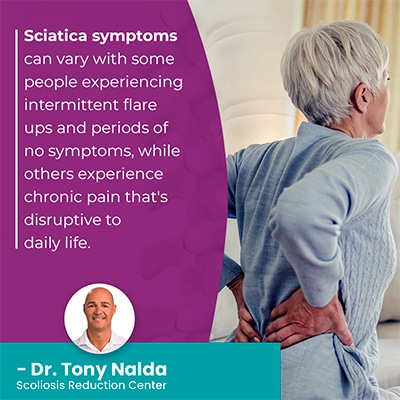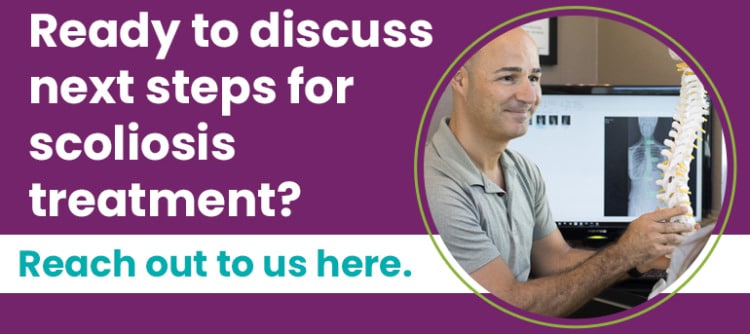What Is the Most Effective Pain Relief for Sciatica?

Although a spinal condition, the effects of scoliosis aren't limited to the spine and its immediate surroundings. If scoliosis develops in the lumbar spine, it can affect the spine, its surrounding muscles, and nerves, and lower body movement.
Scoliosis can affect the body in many different ways. A common complication of lumbar scoliosis is sciatic nerve pain, and the most effective pain relief is achieved through addressing the underlying cause of the nerve pain: the scoliosis itself.
The most effective form of pain relief is determining its underlying cause and treating it accordingly, and when it comes to sciatica pain caused by scoliosis, this means proactively addressing the scoliosis.
Table of Contents
What is Sciatica?
Sciatica isn't a condition itself, although many think it is. The term sciatica refers to a set of symptoms that includes pain and discomfort felt anywhere along the sciatic nerve's pathway but doesn't indicate the cause.
The sciatic nerve starts in the lumbar spine (lower back) and is the largest nerve in the human body; it starts in the lower back and extends down the hip, buttock, leg, and into the foot.
In most cases, sciatica pain is felt down the left side of the body, but it can also affect the right, and in rare cases can affect both.
 The sciatic nerve is a mixed nerve containing both sensory and motor fibers, so symptoms of sciatic nerve compression can involve both sensory and mobility issues.
The sciatic nerve is a mixed nerve containing both sensory and motor fibers, so symptoms of sciatic nerve compression can involve both sensory and mobility issues.
If the sciatic nerve is compressed (exposed to uneven pressure), it can become impinged, inflamed, and irritated, and when this happens, a number of symptoms can develop.
Sciatica Pain
Sciatica pain can range from mild with intermittent flare ups to chronic and debilitating.
It's said that everyone will experience lower back pain at some point in their lives because of the roles of the lumbar spine.
The back can be segmented into three main sections: the cervical spine (neck), thoracic spine (middle/upper back), and the lumbar spine.
Each spinal section has unique roles to play in the spine's biomechanics.
The cervical spine has to support the weight of the head and facilitate the neck's range of motion; the thoracic spine is the largest spinal section, and as the only section attached to the rib cage, it helps protect important organs.
The lumbar spine has to support the weight of the trunk, the spinal sections above, and its vertebrae feel the effects of bending, lifting, and twisting motions.
For those familiar with back pain, it's said that nerve-related back pain can be the most severe pain.
So what does sciatica pain feel like?
Sciatica pain can be felt anywhere along the nerve's extensive pathway and can involve:
- Sharp shooting sensations
- Electric shock-like sensations
- Burning sensations
- Tingling
- Numbness
- Weakness in the leg or foot
- Hip pain
- Back pain
- Leg pain
- Foot pain
 Sciatica symptoms can vary with some people experiencing intermittent flare ups and periods of no symptoms, while others experience chronic pain that's disruptive to daily life.
Sciatica symptoms can vary with some people experiencing intermittent flare ups and periods of no symptoms, while others experience chronic pain that's disruptive to daily life.
Sciatic pain is caused by pressure on the sciatic nerve, so determining the cause of the pressure is the first step in working towards long-term sustainable sciatica pain relief.
Common Causes of Sciatica Nerve Pain
There are multiple causes of sciatic nerve pain, and for any sustainable form of pain relief, the underlying cause has to be determined and inform the crafting of effective treatment plans.
If pain relief is achieved through prescription medications and bed rest, the painful area can return, and if left untreated, a mild ache can become severe pain over time.
Responding to the sciatica symptoms with medication is also just addressing symptoms, and not their underlying cause.
Disc Issues
The spine consists of vertebrae stacked on top of one another, and adjacent vertebrae are separated by an intervertebral disc; these discs perform many functions essential for the spine's biomechanics.
If a disc starts to degenerate, becomes a bulging or herniated disc, and this occurs in the lumbar spine where the sciatic nerve originates, the disc's change in shape and position can compress the nerve and cause sciatica pain.
So the location of a degenerating disc is an important factor, and if disc degeneration is the cause of sciatica pain, the underlying disc issues need to be addressed to relieve pressure on the sciatic nerve.
Disc issues like herniation can be improved through chiropractic care and physical therapy.
Spinal Stenosis
In addition to disc herniation, spinal stenosis is a common cause of sciatica symptoms, and this is a spinal condition that involves a loss of space within the spinal canal, through which the spinal nerves pass.
If stenosis develops in the lumbar spine and causes a loss of space for the sciatic nerve, it can become impinged and irritated, so in these cases, the lumbar spinal stenosis has to be addressed to, again, relieve pressure on the nerve.
Common treatments for spinal stenosis include physical therapy, pain medication, and steroid injections to reduce inflammation.
Bone Spurs
Bone spurs can also expose the sciatic nerve to uneven pressure. Bone spurs are bony overgrowths: projections of bone that form on the edges of bones and where bones meet in the joints.
If a bone spur forms in the lumbar spine and causes compression of the sciatic nerve, the bone spur has to be addressed so pressure on the sciatic nerve is reduced.
Bone spurs won't dissolve on their own, so treatment plans focus on pain management and improving function through physical therapy, medication, and surgery.
Scoliosis
A number of spinal conditions can affect the sciatic nerve, including scoliosis. Scoliosis causes the spine to bend and twist unnaturally, and this can cause compression of the affected spinal section and its surrounding muscles and nerves.
If scoliosis develops in the lumbar spine, a common complication is the development of sciatica pain, and this is because the spine's unnatural bend and twist exposes the sciatic nerve to compression and sciatica pain starts.
And as a progressive condition, the nature of scoliosis is to get worse over time, so if lumbar scoliosis is progressing, the affected nerve will get more irritated over time and symptoms can become more severe and disruptive.
When scoliosis is the cause of the sciatica symptoms, the scoliosis has to be addressed. If the unnatural spinal curve is reduced, inflammation in the spine's surroundings is reduced, and pressure off the spinal nerves is also reduced.
Sciatica treatment is about determining its underlying cause and shaping a treatment plan around it.
While prescription medications and alternating hot and cold packs can help with short-term solutions for pain relief, when it comes to long-term sustainable pain solutions, a proactive treatment is necessary.
A heating pad can also help as can massage therapy, but pinched nerves need to have pressure relieved, and this involves addressing the cause.
Scoliosis can be treated with a variety of non-surgical conservative treatment options capable of impacting conditions on every level.
Through chiropractic care, physical therapy, corrective bracing, and rehabilitation, scoliosis curves can be reduced, and the spine's surrounding muscle balance and strength can be improved for more spinal support and stability, taking pressure off the spine and its nerves within.
Conclusion
The most effective pain relief for sciatica symptoms is determining its underlying cause and addressing and shaping a proactive treatment plan accordingly.
Common sciatica symptoms include pain and discomfort felt along the nerve's pathway, most often down the left side of hip, buttock, leg, and into the foot.
Sciatica pain can feel like sharp shooting sensations, tingling, numbness, and/or leaving it unaddressed can make the pain worse.
While some cases of sciatica, particularly those caused by an overuse injury, can resolve on their own in a matter of weeks, many sciatica patients experience flare ups during which time symptoms intensify then abate, and other patients can experience chronic and debilitating pain that involve also involve muscle tension, muscle pain, and muscle weakness.
While prescription medications, ice packs, and gentle stretching can help with short-term pain relief, when it comes to sustainable long-term pain relief, the best way to decrease pain is treat its cause.
Common causes of sciatica nerve pain include disc degeneration, spinal stenosis, bone spurs, and spinal conditions like scoliosis.
When the sciatic nerve is being exposed to uneven pressure, the nerve loses space to function optimally within, and this can cause a variety of symptoms, and the solution is to take pressure off the nerve and restore the space around the nerve.
Here at the Scoliosis Reduction Center®, sciatica nerve pain is addressed through determining its underlying cause, and if lumbar scoliosis is the cause, reducing the size of the scoliosis through chiropractic care, physical therapy, corrective bracing, and rehabilitation can mean taking pressure off the sciatic nerve and relieving symptoms.
Dr. Tony Nalda
DOCTOR OF CHIROPRACTIC
After receiving an undergraduate degree in psychology and his Doctorate of Chiropractic from Life University, Dr. Nalda settled in Celebration, Florida and proceeded to build one of Central Florida’s most successful chiropractic clinics.
His experience with patients suffering from scoliosis, and the confusion and frustration they faced, led him to seek a specialty in scoliosis care. In 2006 he completed his Intensive Care Certification from CLEAR Institute, a leading scoliosis educational and certification center.
About Dr. Tony Nalda
 Ready to explore scoliosis treatment? Contact Us Now
Ready to explore scoliosis treatment? Contact Us Now





